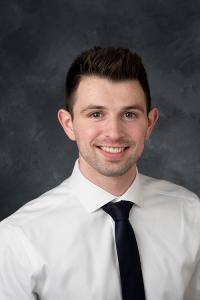Kyle Kinney successfully defended his Ph.D. thesis, "Unweaving the Role of Staphylococcal Enterotoxin C in the Pathogenesis of Infective Endocarditis" on Wednesday, April 8, 2020. 
Background
Kyle was born in Sioux City, Iowa, to David and Cynthia Kinney. Most of his childhood was spent embarrassing his parents by throwing temper tantrums in public to the extent that Kyle was often not taken into public settings anymore. Enrollment in Catholic grade school made Kyle do an abrupt about-face due to the liberally used yardstick to the hand or butt for unruly children.
In high school, he liked most of his subjects but always gravitated towards history and science classes. Though if he was being honest, he was more focused on football and track and field at the time. After graduating high school, Kyle attended Morningside College in Sioux City, Iowa and pursued a double major in biology and chemistry in the hopes of becoming an MD (like every freshman biology major). It was at Morningside that Kyle met Dr. Rachel Robson, who pushed him into looking into a career as a research scientist. He largely ignored this advice till one snowy night in January of 2014, where after a “few” drinks with his friends he discovered that he found microbes more fascinating than most people. Once again, Kyle found himself performing an abrupt about-face that night and decided to pursue a doctorate in microbiology. Hence, alcohol sometimes leads to good decisions. Alas, this decision was made a little too late for the upcoming admission cycle so Kyle decided to gain laboratory experience and found himself as a food microbiologist at Wells Enterprises. Within the next year, Kyle was accepted to the microbiology doctoral program at the University of Iowa.
After two rotations, he decided to pursue training in bacteriology and has worked under the mentorship of Dr. Wilmara Salgado Pabón, studying the role of staphylococcal enterotoxins in S. aureus infective endocarditis (his favorite bacteria). After finishing his degree, Kyle will be headed to Madison, WI, where he has accepted a position as a Keegstra Postdoctoral Researcher in the labs of Dr. Jason Peters and Dr. Tim Donohue at the Great Lakes Bioenergy Research Center. The focus of the position will be to develop genetic and synthetic biology tools for several bioenergy-relevant organisms for the sustainable conversion of plant material into biofuels and products.
Outside of lab, Kyle enjoys spending time with his girlfriend Jordan and their two dogs Ruby and Bella (Rubella). He has several hobbies that include running, lifting weights, biking, playing games, and reading. He is passionately interested in World War history and devoted much of his small book library to the subject. If he had unlimited time and money he would love to earn a graduate degree in history focusing on the portrait of the world in the prewar era (1890-1914). Most people do not know that this critical bit of time has shaped much of the world into what we know today. You can imagine how exciting Kyle is at dinner parties with all his knowledge of late 1800 European affairs……maybe you don’t want to imagine that.
Research
Staphylococcus aureus is the leading cause of infective endocarditis (IE) in the United States. IE is an infection of the heart endothelium characterized by vegetative growths on the valves of the heart. The vegetations cause direct damage to the valve and underlying cardiac structures, and can further cause systemic complications by forming septic emboli. Recent evidence has shown the importance of staphylococcal superantigens (SAg) in the pathogenesis of IE; however, the mechanism for their importance is not known.
The SAg, staphylococcal enterotoxin C (SEC), is critical for Staphylococcus aureus IE as tested in rabbits. Its hallmark function and most potent biological activity is hyperactivation of the adaptive immune system. Superantigenicity was proposed as a major underlying mechanism driving IE but was not directly tested. With the use of S. aureus MW2 expressing SEC toxoids, we show that superantigenicity does not contribute to vegetation growth, to the magnitude of myocardial inflammation or to acute kidney injury. In contrast, superantigenicity contributes to hepatocellular injury and overall systemic toxicity. Recent studies indicate that SAgs directly inhibit endothelial cell migration. We show that SEC inhibits production of serpin E1, crucial in cell migration and vascular repair. This may be central to SEC’s role in IE. This study highlights the critical contribution of an alternative function of SAgs to IE and broadens our current understanding of these molecules.
The CC5 S. aureus clonal group has a high frequency of infection around the globe and is one of the most common clonal groups isolated from IE patients. However, the mechanistic studies of pathogenesis in this clonal group is lacking. Moreover, CC5 isolates encode the highly prevalent enterotoxin gene cluster (egc), which is an operon of 6 SAgs that SEM, SEN, SEO, SEI, SEG, and SE-like U. Much still remains unknown regarding the egc SAgs, from their expression patterns across invasive strains to their contribution to S. aureus colonization and invasion. Here we established a CC5 cohort as model group to study pathogenesis in the rabbit model of IE. Overall, the CC5 cohort caused large vegetative growths on the valves of the heart along with similar magnitudes of acute kidney, liver, and lung pathology to well-studied strains. Taken together, this work establishes a new mechanistic basis for superantigens involvement in S. aureus infective endocarditis and opens the door for new mechanistic studies of the egc with the CC5 S. aureus clonal lineage.